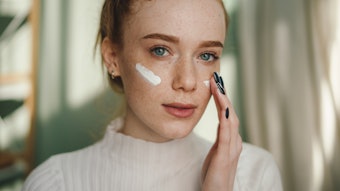
Read the full article in the April 2021 digital edition. . .
Editor’s note: The present article proposes a novel conjugate for the formulation of anti-aging and anti-acne cosmetics. In relation, readers are reminded that in the United States, anti-acne products are regulated as over-the-counter (OTC) drugs by the U.S. Food and Drug Administration (FDA). As such, formulas must follow the monograph if anti-acne treatment claims are to be made on products.
Retinoids are a group of active molecules comprising vitamin A and its natural and synthetic derivatives. Commonly used in cosmetic products, these lipophilic molecules bind to specific nuclear receptors that modulate the expression of genes involved in cellular proliferation and differentiation,1 e.g., of keratinocytes, which can normalize desquamation.2 The topical application of retinoic acid, for one, has been shown to improve clinical features of aged skin by reducing wrinkles and diminishing hyperpigmentation.3
Products based on retinoids are U.S. Food and Drug Administration (FDA)-approved ingredients for topical acne therapies. Clinical data shows these agents to be highly efficacious on both non-inflammatory and inflammatory acne lesions2, 4 due to their comedolytic and anti-inflammatory effects.4 The mechanism of action for retinoids is based on their ability to block several important inflammatory pathways that are activated in acne: toll-like receptors, leukocyte migration and the AP 1 pathway.5
In parallel, hyaluronic acid (HA) that naturally occurs in the human body plays a multifaceted role in regulating various biological processes such as skin repair, wound healing and tissue regeneration, and shows immunomodulating properties.6, 7 Due to its strong water-binding potential, HA helps the skin to hold and maintain elasticity and moisture, and as such, is widely used as an active ingredient in cosmetic formulations to improve skin hydration and overall signs of aging.8, 9
Taken together, the present work explored the biological effects of a novel ester composed of low molecular weight (LMW) HA substituted with retinoic acida, which was prepared with the aim of combining the unique features of each material to improve stability, facilitate skin penetration and enhance their impact on various skin properties. Specific parameters of the conjugate were tested as described here, including effects on inflammation, erythema, sebum levels and pore size, in relation to acne; collagen and fibronectin, hydration, skin structure and wrinkles/elasticity, for anti-aging effects; and overall penetration into the dermis.
Acne Assessments
Retinoids are often the first choice for acne treatments as they have been found to decrease sebaceous gland size, inhibit lipogenesis,10, 12 induce sebocyte apoptosis12 and possess anti-inflammatory properties.13 Their significant anti-inflammatory effects are mediated by the inhibition of various immune factors, including pro-inflammatory cytokine production.14, 15 These effects were measured in vitro in HaCaT keratinocytes treated with or without the test conjugatea.
Pro-inflammatory cytokine expression in vitro: Inflammation was induced in HaCaT keratinocytes treated by UVB irradiation (10 mJ/cm2), after which the cells were treated with either 100 µg/mL of HA, or 100 µg/mL (= 5 International Units, IU) of the test conjugate or other retinoids including retinol, retinyl palmitate and retinyl acetate (5 IU) for 24 hr. The expression of the IL-6 gene was determined by qRT-PCR. A student’s t-test was used for statistical analysis (**p < 0.01, in comparison with UV-irradiated control).
Results of cytokine expression: Results showed the test conjugate (100 µg/mL) reduced the expression of pro-inflammatory cytokines interleukins-6 after UVB irradiation in vitro. The anti-inflammatory activity of the test material appeared to be stronger than for HA alone or the other retinoids used at equal IUs (see Figure 1).
Sebum, erythema and pore size in vivo: Next, in vivo assessments were made of creams with or without (placebo) the test conjugate in a panel of 14 Caucasian women (ages 37-58) with normal, non-acneic skin. The test subjects applied a cream with 0.01% of the test conjugate once daily for six weeks to one half of their face and a placebo cream to the other half. Measurements were obtained at 0, 14, 28 and 42 days for sebum contentb, erythema indexc and skin pore size; the latter was determined by analyzing pictures captured by a high-resolution camerad.
Results of sebum, erythema and pore size tests: Results showed the test conjugate down-regulated sebum content and reduced the number and size of skin pores (see Figure 2a-d). Moreover, a decrease in the erythema index was noted (see Figure 2b; p = 0.0324). These results confirmed the anti-inflammatory properties of the test conjugate as well as its non-irritating status after prolonged use; this is in contrast to other retinoids, where irritation is common.16 The material can therefore also be deemed suitable for sensitive skin.
Blemishes and erythema in vivo and subjective reports: In a second in vivo evaluation, a cream containing 0.01% of the test conjugate was applied to one half of the face by 16 volunteers (1 man, 15 women) having problematic acne-prone skin once daily for four weeks; a placebo cream was applied to the other half of the face. Representative pictures of overall skin condition on the cheeks were taken before and after four weeks of application. Subjective evaluations of changes in various acne-related parameters were reported by the volunteers via a questionnaire.
. . .Read more in the April 2021 digital edition. . .
References
- Sorg, O., et al. (2006). Retinoids in cosmeceuticals. Dermatol Ther 19(5) 289-96.
- Gollnick, H.P. (2015). From new findings in acne pathogenesis to new approaches in treatment. J Eur Acad Dermatol Venereol 29 suppl 5 1-7.
- Fisher, G.J., et al. (1999). Molecular mechanisms of photoaging in human skin in vivo and their prevention by all-trans retinoic acid. Photochem Photobiol 69(2) 154-7.
- Leyden, J., Stein-Gold, L. and Weiss, J. (2017). Why topical retinoids are mainstay of therapy for acne. Dermatol Ther (Heidelb) 7(3) 293-304.
- Czernielewski, J., et al. (2001). Adapalene biochemistry and the evolution of a new topical retinoid for treatment of acne. J Eur Acad Dermatol Venereol 15 suppl 3 5-12.
- Chen, L.H., et al. (2018). Hyaluronic acid, an efficient biomacromolecule for treatment of inflammatory skin and joint diseases: A review of recent developments and critical appraisal of preclinical and clinical investigations. Int J Biol Macromol 116 572-584.
- Narurkar, V.A., et al. (2016). Rejuvenating hydrator: Restoring epidermal hyaluronic acid homeostasis with instant benefits. J Drugs Dermatol 15(1 suppl 2) s24-37.
- Wang, F., et al. (2007). In vivo stimulation of de novo collagen production caused by cross-linked hyaluronic acid dermal filler injections in photodamaged human skin. Arch Dermatol 143(2) 155-63.
- Stern, R. and Maibach, H.I. (2008). Hyaluronan in skin: Aspects of aging and its pharmacologic modulation. Clin Dermatol 26(2) 106-22.
- Landthaler, M., et al. (1980). Inhibitory effects of 13-cis-retinoic acid on human sebaceous glands. Arch Dermatol Res 269(3) 297-309.
- Zouboulis, C.C., et al. (1991). Effects of 13-cis-retinoic acid, all-trans-retinoic acid, and acitretin on the proliferation, lipid synthesis and keratin expression of cultured human sebocytes in vitro. J Invest Dermatol 96(5) 792-7.
- Nelson, A.M., et al. (2011). TRAIL contributes to the apoptotic effect of 13-cis retinoic acid in human sebaceous gland cells. Br J Dermatol 165(3) 526-33.
- Leyden, J.J., et al. (2005). Topical retinoids in inflammatory acne: A retrospective, investigator-blinded, vehicle-controlled, photographic assessment. Clin Ther 27(2) 216-24.
- Mathew, J.S. and Sharma, R.P. (2000). Effect of all-trans-retinoic acid on cytokine production in a murine macrophage cell line. Int J Immunopharmacol 22(9) 693-706.
- Liu, P.T., et al. (2005). Cutting edge: All-trans retinoic acid down-regulates TLR2 expression and function. J Immunol 174(5) 2467-70.
- Mukherjee, S., et al. (2006). Retinoids in the treatment of skin aging: An overview of clinical efficacy and safety. Clin Interv Aging 1(4) 327-48.
a HyRetin (INCI: Sodium Retinoyl Hyaluronate), Contipro, A.S.
b Sebumeter
c Mexameter
d VisioFace











